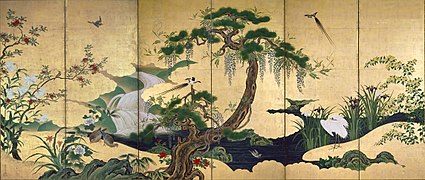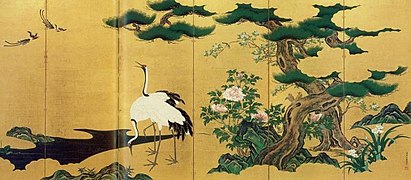Kanō Einō
Kanō Einō ( Japanese 狩 野 永 納 , actually Kanō Yoshinobu ( 狩 野 吉 信 ), common nickname Nuidonosuke ( 縫 殿 助 ); born August 18, 1631 in Kyōto ; died April 27, 1697 ibid) was a Japanese painter of the Kanō school during the early Edo period .
life and work
Einō was the eldest son of Kanō Sansetsu . First he studied under his father, later he is said to have trained under Kanō Yasunobu . He was not only a painter and, after his father, the third head of the Kyō branch of the Kanō school, but also an outstanding art historian. He was able to rely on the records of his father Sansetsu, but expanded them considerably and in 1693 published the five-volume "History of Court Painting " ( 本 朝 画 史 , Honchō gashi ), which is still an important source of information today.
Einō died at the age of 66 and was buried on Sennyū-ji in Kyōto.
His most famous works are the pair of adjustable screens and the wall paintings ( 障 壁画 , Shōheki-ga ) in the temple Engyō-ji in Himeji .
photos
Remarks
- ↑ Owned by the Suntory Art Museum . Excerpts from this screen appeared as a set of Japanese Postage stamps.
Individual evidence
- ↑ a b Owned by the Idemitsu Art Museum .
literature
- Tazawa, Yutaka: Kanō Einō . In: Biographical Dictionary of Japanese Art . Kodansha International, 1981. ISBN 0-87011-488-3 .
- Laurance P. Roberts: Kanō Einō . In: A Dictionary of Japanese Artists . Weatherhill, 1976. ISBN 0-8348-0113-2 .
Web links
| personal data | |
|---|---|
| SURNAME | Kanō, Einō |
| ALTERNATIVE NAMES | 狩 野 永 納 (Japanese); Kanō, Yoshinobu (real name); 狩 野 吉 信 (real name, Japanese) |
| BRIEF DESCRIPTION | Japanese painter |
| DATE OF BIRTH | August 18, 1631 |
| PLACE OF BIRTH | Kyoto |
| DATE OF DEATH | April 27, 1697 |
| Place of death | Kyoto |


